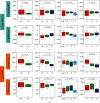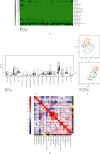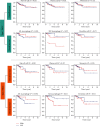Immune Cell Infiltration and Identifying Genes of Prognostic Value in the Papillary Renal Cell Carcinoma Microenvironment by Bioinformatics Analysis
- PMID: 32775427
- PMCID: PMC7399742
- DOI: 10.1155/2020/5019746
Immune Cell Infiltration and Identifying Genes of Prognostic Value in the Papillary Renal Cell Carcinoma Microenvironment by Bioinformatics Analysis
Abstract
Papillary renal cell carcinoma (PRCC) is one of the most common histological subtypes of renal cell carcinoma. Type 1 and type 2 PRCC are reported to be clinically and biologically distinct. However, little is known about immune infiltration and the expression patterns of immune-related genes in these two histologic subtypes, thereby limiting the development of immunotherapy for PRCC. Thus, we analyzed the expression of 22 immune cells in type 1 and type 2 PRCC tissues by combining The Cancer Genome Atlas (TCGA) database with the ESTIMATE and CIBERSORT algorithms. Subsequently, we extracted a list of differentially expressed genes associated with the immune microenvironment. Multichip mRNA microarray data sets for PRCC were downloaded from the Gene Expression Omnibus (GEO) to further validate our findings. We found that the immune scores and stromal scores were associated with overall survival in patients with type 2 PRCC rather than type 1 PRCC. Tumor-infiltrating M1 and M2 macrophages could predict the clinical outcome by reflecting the host's immune capacity against type 2 PRCC. Furthermore, CCL19/CCR7, CXCL12/CXCR4, and CCL20/CCR6 were shown to be potential new targets for tumor gene therapy in type 2 PRCC. Our findings provide valuable resources for improving immunotherapy for PRCC.
Copyright © 2020 Ting Liu et al.
Conflict of interest statement
The authors declare that there is no conflict of interest regarding the publication of this paper.
Figures






References
MeSH terms
Substances
LinkOut - more resources
Full Text Sources
Medical

